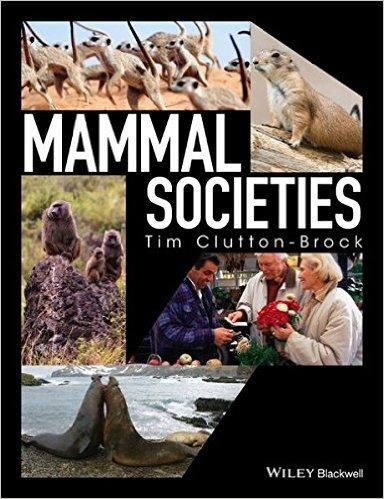
Submitted by Administrator on Tue, 31/05/2016 - 11:53
MAMMAL SOCIETIES - published on 27 May 2016
To understand the evolutionary processes that have led to the development of human societies, it is necessary to appreciate the causes and consequences of contrasts in social organisation in other mammals. Over the last fifty years, behavioural biologists have documented the social behaviour of chimpanzees and gorillas, lions and meerkats, prairie dogs and ground squirrels, zebras and red deer and many others, providing insight into the size and structure of social groups, the reproductive behaviour of both sexes and the extent of competition and cooperation.
Mammal Societies provides the first synthesis of research on social behaviour, integrating comparative, observational and experimental studies within the explanatory framework of evolutionary and ecological theory. The book shows how the distribution of resources and the foraging strategies of individuals affect the size of groups; how they interact with contrasts in reproductive behaviour and contrasts in breeding systems to affect patterns of kinship; and how contrasts in kinship affect social relationships, competitive interactions and cooperation. It explains how similar principles apply in contrasting taxonomic groups, sometimes generating similar correlations between ecology and behaviour but sometimes interacting with contrasts in demographic parameters to generate contrasting patterns.
A recurrent theme is the extent to which males and females differ – while the distribution and behaviour of females is constrained by their need to acquire resources that can be converted into offspring, the distribution and behaviour of males has evolved to maximise their access to females. The first half of the book explores social relationships in females dealing in turn with contrasts in sociality and dispersal, mate choice and parental care, communication, competition and cooperation, while the second half covers similar topics in males. Later chapters examine the evolution of cooperative breeding and sex differences and the book ends with two chapters that review evolutionary studies of human societies. The many photographs that illustrate the text provide revealing glimpses of the social interactions that underline contrasting relationships. They range from extremes of competition (grandmothers killing their grand-offspring to increase their own breeding success; males killing the dependent offspring of prospective mates) to extremes of cooperation (females helping each other to give birth or to nurse their offspring; males caring for orphaned juveniles).
The final two chapters review similar studies of hominins and humans and emphasise the contrasts between humans and other mammals rather than the similarities. Unlike other animals, humans can make agreements and social contracts that are enforced by joint action, paving the way for the development of cooperation between strangers, the proliferation of exchanges, trading and barter and the evolution of ethical systems and religious beliefs, encouraging cooperation and constraining many of the more extreme forms of competition found in other mammals.
